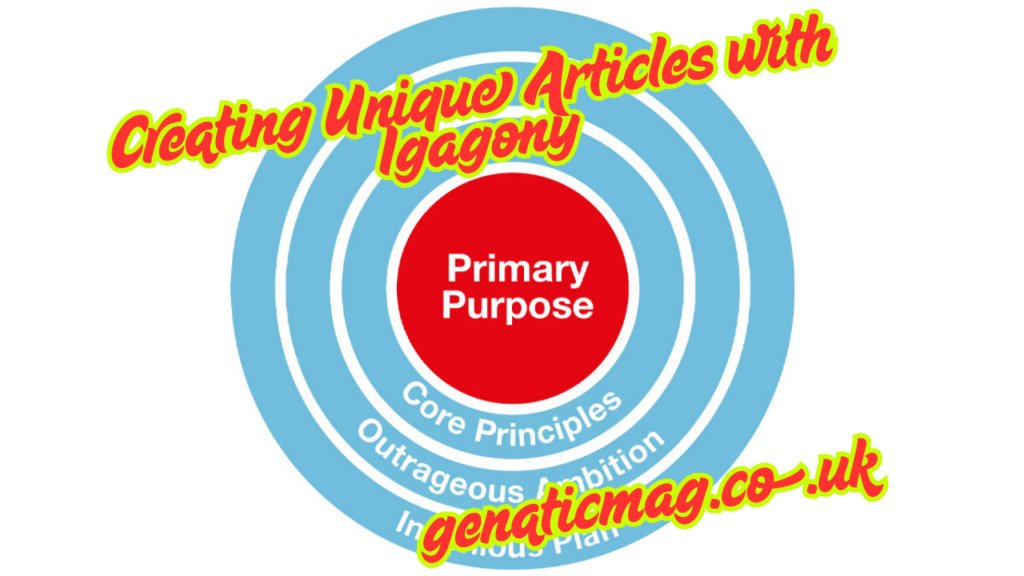In the constantly-evolving world of digital content, distinguishing out from the crowd is more challenging—and more important—than ever. As producers, authors, and marketers attempt to generate stories that are not only entertaining but also extremely distinctive, tools like Igagony are increasing in favor for their ability to inspire creativity, structure, and voice. This article examines the whole path of Creating Unique Articles using Igagony: A Guide to Best Practices, ??, (In Title Make a Sense) and why this technique may alter the way we generate content.
Understanding the Value of Uniqueness in Content

Before getting into the intricacies of Igagony, it’s vital to understand why unique content matter in today’s digital world. Search engines reward unique content, viewers desire real voices, and companies develop trust with different storytelling. Uniqueness isn’t merely a stylistic choice—it’s a strategic need.
In this context, the title Creating Unique Articles with Igagony: A Guide to Best Practices, ??, (In Title Make a Sense) becomes a rallying call for writers aiming to balance creativity with coherence, functionality with flair.
What Is Igagony and Why Should You Use It?

Igagony isn’t just another writing tool; it’s a system designed to push boundaries and spark new angles. While its name might sound quirky or experimental, its purpose is anything but. Igagony focuses on aiding writers through structure, theme prompts, syntax variations, and a unique contextual engine that helps develop one-of-a-kind articles.
This makes it especially effective when applying the philosophy behind Creating Unique Articles with Igagony: A Guide to Best Practices, ??, (In Title Make a Sense). It turns abstract ideas into grounded, readable, and yet completely individual works.
Planning Before You Write: A Core Principle

One of the most effective strategies in Creating Unique Articles with Igagony: A Guide to Best Practices, ??, (In Title Make a Sense) is the planning phase. Even the most creative outputs need structure. Igagony allows users to sketch outlines, define tone, and map content flow before a single word is typed.
Here are a few tips for the planning phase:
- Topic Mapping: Choose your angle. What subtopics are underexplored? Where can you offer a new lens?
- Keyword Framing: Without changing the central keyword, identify related terms that can organically enhance SEO.
- Audience Identification: Understand who you’re writing for, as Igagony’s suggestions adapt based on audience style.
Structuring the Article: Building a Cohesive Narrative
Structure matters as much as originality. While Creating Unique Articles with Igagony: A Guide to Best Practices, ??, (In Title Make a Sense) sounds avant-garde, its implementation relies on cohesive, readable formatting. Igagony assists users in maintaining reader-friendly layout patterns.
Suggested Structure via Igagony:
- Introduction – Establish the topic and intrigue.
- Context & Background – Discuss the need for unique content.
- Tool Use & Strategy – Explain how Igagony assists.
- Actionable Tips – Provide steps to replicate success.
- Final Thoughts – Tie everything together with a reflective conclusion.
This structured approach is essential to delivering quality while adhering to the theme of uniqueness.
Techniques for Creating One-of-a-Kind Content with Igagony
The heart of this guide is about applying actual techniques. Let’s break down key practices you can employ with Igagony to ensure your article lives up to the promise of Creating Unique Articles with Igagony: A Guide to Best Practices, ??, (In Title Make a Sense).
1. Semantic Layering
Use Igagony to insert layered meaning through synonyms and thematic shifts. This practice prevents redundancy and keeps readers engaged.
2. Controlled Creativity
Igagony offers syntax flexibility but with guardrails. You can explore metaphors, rhetorical questions, or poetic descriptions without losing readability.
3. Voice Customization
Set tone parameters—formal, quirky, academic, or conversational. This tool will maintain consistency across paragraphs, which is vital in long-form writing.
Common Mistakes to Avoid While Using Igagony
Even the most powerful tools can be misused. Here are a few pitfalls to sidestep:
- Overcomplicating Language: Unique doesn’t mean convoluted. Simplicity has power.
- Ignoring Article Flow: Jumping from topic to topic can confuse readers. Maintain logical transitions.
- Underutilizing Prompts: Igagony provides prompt cues—use them to expand depth and coverage.
Each of these missteps can derail your attempt at Creating Unique Articles with Igagony: A Guide to Best Practices, ??, (In Title Make a Sense), no matter how creative the premise.
The Role of Revision in Unique Article Development
Once the draft is complete, the real magic begins in revision. Igagony supports adaptive feedback, helping writers spot redundancy, tone inconsistencies, or underdeveloped ideas. This aligns with one of the most overlooked best practices: rewriting to refine uniqueness.
Steps in the revision phase:
- Run the uniqueness scan.
- Use the “perspective shift” mode to view your article through different audience lenses.
- Trim or expand sections for balance and rhythm.
Revising is not just correcting—it’s about enhancing the unique fingerprint of your article.
Conclusion: A New Standard for Originality
Creating Unique Articles with Igagony: A Guide to Best Practices, ??, (In Title Make a Sense) is more than a catchy title—it’s a philosophy. It invites writers to embrace difference, celebrate voice, and apply structure with purpose. Igagony empowers this mission by giving creators tools that are both flexible and smart, making originality an achievable standard, not just a lofty ideal.
As the content world continues to grow, so too must our approaches. Igagony stands out as a companion, not a crutch—guiding you toward becoming a sharper, bolder, and more expressive writer.
Also Read : Creating Unique Articles with Igagony: A Guide to Best Practices
